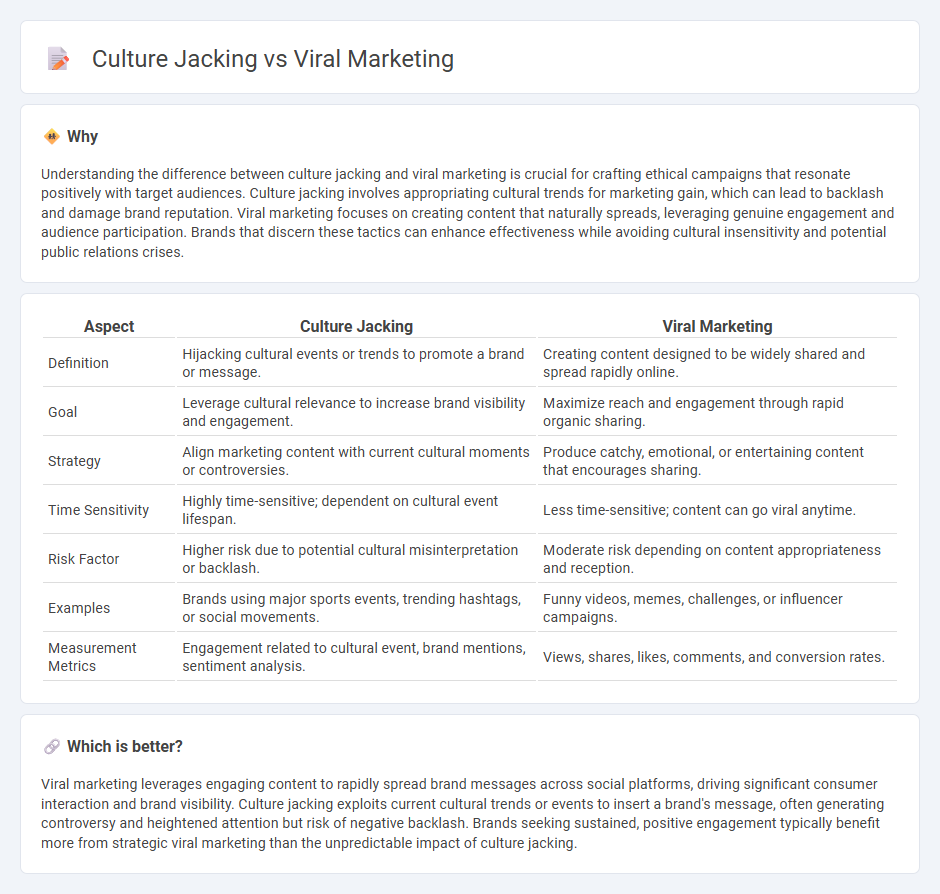
Culture jacking leverages existing cultural trends to insert brand messages into ongoing conversations, creating authentic and timely engagement. Viral marketing relies on creating highly shareable content designed to spread rapidly among target audiences, maximizing reach through social sharing. Explore deeper insights into how these marketing strategies can elevate brand visibility and consumer connection.
Why it is important
Understanding the difference between culture jacking and viral marketing is crucial for crafting ethical campaigns that resonate positively with target audiences. Culture jacking involves appropriating cultural trends for marketing gain, which can lead to backlash and damage brand reputation. Viral marketing focuses on creating content that naturally spreads, leveraging genuine engagement and audience participation. Brands that discern these tactics can enhance effectiveness while avoiding cultural insensitivity and potential public relations crises.
Comparison Table
| Aspect | Culture Jacking | Viral Marketing |
|---|---|---|
| Definition | Hijacking cultural events or trends to promote a brand or message. | Creating content designed to be widely shared and spread rapidly online. |
| Goal | Leverage cultural relevance to increase brand visibility and engagement. | Maximize reach and engagement through rapid organic sharing. |
| Strategy | Align marketing content with current cultural moments or controversies. | Produce catchy, emotional, or entertaining content that encourages sharing. |
| Time Sensitivity | Highly time-sensitive; dependent on cultural event lifespan. | Less time-sensitive; content can go viral anytime. |
| Risk Factor | Higher risk due to potential cultural misinterpretation or backlash. | Moderate risk depending on content appropriateness and reception. |
| Examples | Brands using major sports events, trending hashtags, or social movements. | Funny videos, memes, challenges, or influencer campaigns. |
| Measurement Metrics | Engagement related to cultural event, brand mentions, sentiment analysis. | Views, shares, likes, comments, and conversion rates. |
Which is better?
Viral marketing leverages engaging content to rapidly spread brand messages across social platforms, driving significant consumer interaction and brand visibility. Culture jacking exploits current cultural trends or events to insert a brand's message, often generating controversy and heightened attention but risk of negative backlash. Brands seeking sustained, positive engagement typically benefit more from strategic viral marketing than the unpredictable impact of culture jacking.
Connection
Culture jacking leverages current cultural trends and social movements to create marketing content that resonates deeply with target audiences, enhancing engagement. Viral marketing amplifies this effect by encouraging rapid sharing and participation, turning culturally relevant messages into widespread phenomena. The synergy between culture jacking and viral marketing drives increased brand visibility and emotional connection in digital landscapes.
Key Terms
**Viral Marketing:**
Viral marketing leverages compelling content to rapidly spread brand messages through social sharing, maximizing reach and engagement across social media platforms. It focuses on creating emotionally resonant and easily shareable campaigns that encourage user participation and organic growth. Explore successful viral marketing strategies to amplify your brand's presence effectively.
Shareability
Viral marketing leverages highly shareable content designed to rapidly spread through social networks by tapping into popular trends and emotional triggers, maximizing engagement and visibility. Culture jacking involves appropriating or referencing cultural phenomena to create buzz, often provoking strong reactions that boost shareability but may risk backlash. Explore how these strategies can amplify brand presence and harness shareability to achieve impactful marketing results.
Word-of-mouth
Viral marketing leverages organic word-of-mouth by encouraging audiences to share content widely, increasing brand visibility through authentic engagement and emotional appeal. Culture jacking, on the other hand, strategically hijacks current cultural trends or conversations to insert brand messages, sparking buzz and debates that amplify word-of-mouth rapidly. Explore how these tactics differ in driving consumer conversations and brand influence.
Source and External Links
Viral marketing - Wikipedia - Viral marketing is a strategy that uses existing social networks to promote products, relying on consumers to spread information quickly like a virus, often via social media, email, videos, and other digital means, aiming to reach individuals with high social networking potential to maximize sharing.
Viral Marketing: Advantages, Disadvantages, Examples and FAQs - Viral marketing leverages captivating, share-worthy content to quickly disseminate brand messages through social media and word-of-mouth, relying on the content's appeal to motivate voluntary sharing that leads to exponential reach and brand recognition.
What is Viral Marketing? | Directive - Viral marketing is a digital strategy aiming to spread content organically among wide audiences primarily through social sharing rather than paid promotion, where rapid and repeated sharing by influential users can result in massive engagement and national or international visibility.
 dowidth.com
dowidth.com